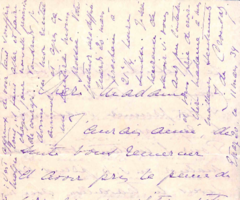Suite orientale for violin (or flute), cello and piano
1. Prélude – 2. Danse d’almées – 3. Ronde de nuit
The genesis of Mel Bonis’s Suite orientale proves rather complex. The title of the work appears in the programme of a concert given on 23 March 1899 at the Salle Pleyel. It then comprised four movements: “Prélude”, “Danse d’almées”, “Ronde de nuit” and “Nocturne”. The scoring (oboe, horn, cello and chromatic harp) is identical to that of an 1898 Suite considered lost. Did she adapt her score for a piano trio and delete the last movement? Later, she orchestrated the “Prélude” and “Danse d’almées”, which were conducted by Pierre Monteux on 15 December 1906. The symphonic version of “Ronde de nuit”, which survives as separate parts, seems to have been cut out before this concert. In this exotically tinged work, Mel Bonis draws on a favourite source of inspiration for French artists of her time. The Orient is evoked through harmonic pedal-points, modal colours often resulting from the elision of the leading tone, strange melodic contours, melismas and ornamental figures. But the exoticism is rather subdued. In the central movement, the almas’ dance remains decent, without risking the sensuality that the French generally believed typical of Oriental women. The Suite orientale is nevertheless notable for its construction, which does away with tonal unity: the movements (all in the minor mode) are respectively in D minor, A minor and F minor. Moreover, it ends with a slow movement, much longer than the other two. This “Ronde de nuit” bears an indication that makes it slightly more programmatic: “Midnight rings in the distance”, the left hand suggesting the strokes of the bell.



